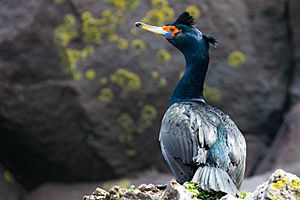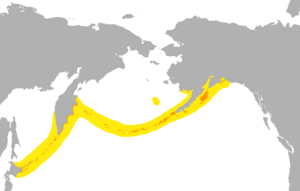Red-faced cormorant facts for kids
Quick facts for kids Red-faced cormorant |
|
|---|---|
 |
|
| Conservation status | |
| Scientific classification | |
| Genus: |
Phalacrocorax
|
| Species: |
urile
|
 |
|
| Approximate range | |
The red-faced cormorant (Phalacrocorax urile) is a special type of bird. It is also known as the red-faced shag or violet shag. This bird belongs to the cormorant family, which are known for diving into water to catch fish.
Contents
Where Red-faced Cormorants Live
This amazing bird lives in a wide area across the northern Pacific Ocean. You can find it from the eastern part of Hokkaidō in Japan. Its home also includes the Kuril Islands and the southern tip of the Kamchatka Peninsula.
From there, its range stretches through the Aleutian Arc all the way to the Alaska Peninsula and the Gulf of Alaska. These birds prefer coastal areas where they can easily find food.
About This Unique Bird
The red-faced cormorant is quite similar to another bird called the pelagic cormorant. They even live in some of the same places. Scientists sometimes group them together in a different genus called Leucocarbo.
Interestingly, where these two cormorant types nest together, the red-faced cormorant often has more success raising its young. Its numbers seem to be growing, especially in the eastern parts of its range. Even so, people are still a bit worried about its future. This is mainly because we don't know as much about this bird as we'd like to.
What Red-faced Cormorants Look Like
Adult red-faced cormorants have beautiful, shiny feathers. Their body is a deep greenish-blue color. On their back and sides, the feathers can look purplish or even bronze.
When it's breeding season, these birds look even more special. They grow two crests on their head. They also have white feathers on their sides, neck, and rump. The skin on their face, around their eyes, is a bright orange or red. This bright color is how the bird got its name! Even when it's not breeding season, the red face helps tell it apart from the similar pelagic cormorant.
Their legs and feet are a brownish-black color. Their wings are usually between 25 and 29 centimeters long. Female birds tend to have wings about 5 centimeters shorter than males. Adult cormorants weigh between 1.5 and 2.3 kilograms. Females are usually about 350 grams lighter than males.
What Red-faced Cormorants Eat
Red-faced cormorants mainly eat food they find at the bottom of the ocean. They especially like to eat small fish called cottids. Scientists learn this by looking at what's inside their stomachs.
Who Hunts Red-faced Cormorants
Adult red-faced cormorants don't have many animals that hunt them. Sometimes, river otters might try to catch them. Different types of crows and bald eagles or golden eagles can also be predators. However, gulls and crows are more common hunters of their eggs and baby chicks.
See also
 In Spanish: Cormorán carirrojo para niños
In Spanish: Cormorán carirrojo para niños


